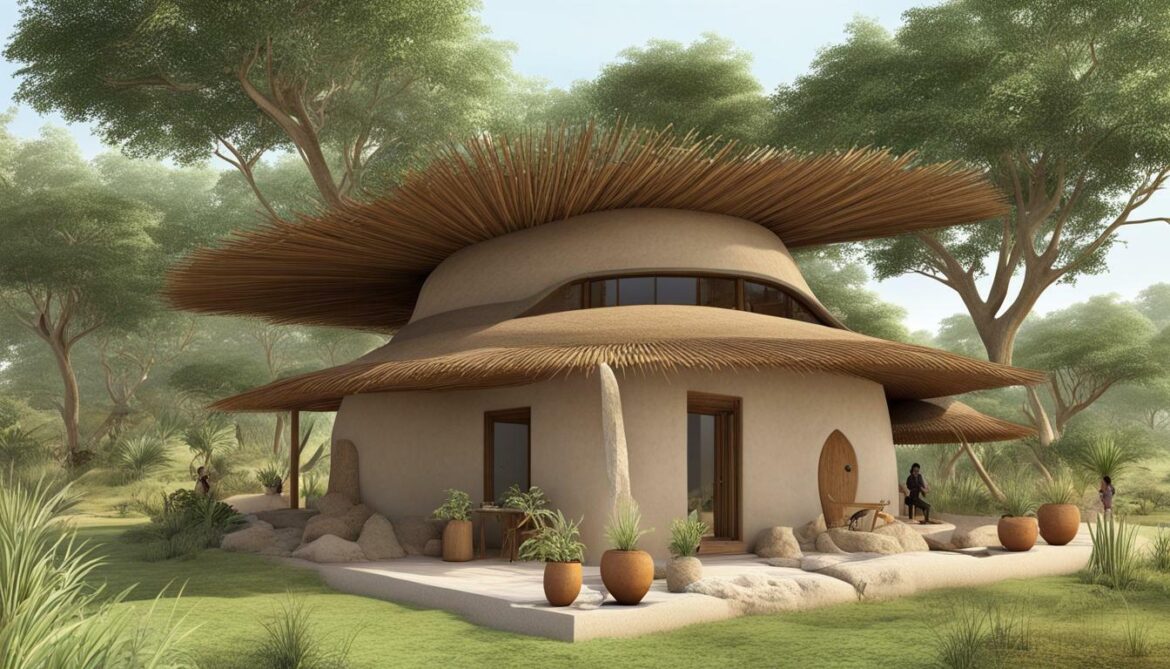Sustainable architecture is not merely a trend; it is a necessary response to environmental challenges and a means of honoring our cultural heritage and historical architecture.
By integrating traditional building techniques into modern architecture, it is possible to create structures that are both environmentally friendly and deeply rooted in historical context.
This article will explore the concept of sustainable architecture, the advantages of employing time-honored methods, and practical examples such as adobe construction, timber framing, and straw bale construction.
Additionally, the discussion will address the challenges encountered in this field and propose solutions for effectively merging tradition with modern sustainable practices.
We invite you to engage with us as we embark on this journey toward a more sustainable future in architecture, incorporating biophilic design to connect occupants with nature.
What is Sustainable Architecture?
.jpg_00.jpeg)
Sustainable architecture represents a design approach aimed at minimizing the environmental impact of buildings through meticulous consideration of energy efficiency, resource conservation, and the selection of eco-friendly materials. It often includes passive design strategies and natural ventilation to enhance thermal performance.
This approach integrates principles of passive design, with the objective of creating structures that harmonize with their surroundings while effectively reducing the overall ecological footprint. Incorporating natural lighting and building orientation can significantly reduce energy consumption.
This architectural philosophy not only enhances the quality of life for occupants but also promotes environmental sustainability by utilizing renewable resources, green building practices, and innovative construction methods.
By adhering to these principles, sustainable architecture seeks to deliver long-term benefits for communities and future generations, ensuring a low-impact construction approach.
Defining Sustainable Architecture
Defining sustainable architecture requires a comprehensive understanding of its fundamental principles, which prioritize the creation of buildings that are environmentally responsible and resource-efficient throughout their entire lifecycle, including a focus on energy-efficient systems and sustainable urban planning.
These principles include a diverse array of practices aimed at minimizing the ecological footprint associated with construction and occupancy. Key areas of focus include energy efficiency, the utilization of renewable materials, waste reduction, and the use of natural plasters and non-toxic materials.
By incorporating strategies such as passive solar design, effective insulation techniques, and energy-efficient systems, sustainable architecture significantly reduces energy consumption, which is vital in both urban and rural contexts.
In urban environments, the adaptive reuse of existing structures can lead to a reduction in demolition waste, while in rural areas, emphasizing local resources and designs that harmonize with the surrounding landscape can enhance environmental sustainability. Additionally, the integration of green roofs and living walls can further reduce the ecological footprint.
Ultimately, the objective of sustainable architecture is to create a balance between human activity and the natural environment, ensuring that buildings not only fulfill the needs of their occupants but also contribute positively to the health and well-being of the planet. This involves incorporating techniques such as rainwater harvesting, sustainable landscaping, and permaculture design.
Why Use Traditional Building Techniques in Sustainable Architecture?
The application of traditional building techniques in sustainable architecture presents various advantages, including improved environmental sustainability, the preservation of cultural heritage, and the efficient conservation of resources. These techniques also emphasize durability and resource efficiency.
These time-honored methods frequently employ local materials and traditional craftsmanship, which not only diminishes the carbon footprint associated with transportation but also encourages community engagement and bolsters local economies.
By incorporating these techniques into contemporary designs, architects can enhance both the structural integrity and aesthetic appeal of buildings, while fostering a deeper connection between the environment and its users. This integration also promotes the use of bioclimatic design and regional architecture.
This harmonious integration of tradition and innovation yields sustainable solutions that respect historical practices while effectively addressing modern challenges, including climate adaptation and resilience engineering.
1. Environmental Benefits
Traditional building techniques offer substantial environmental advantages by promoting the utilization of renewable resources and minimizing energy consumption through established energy-efficient practices. Techniques like building orientation and natural ventilation enhance thermal performance.
These practices frequently involve the use of locally sourced materials, such as timber and clay, which not only decrease transportation-related emissions but also bolster local economies. For example, straw bale construction is recognized for its excellent insulating properties, significantly reducing heating and cooling expenses and incorporating traditional masonry techniques.
The incorporation of passive solar design enables structures to effectively harness sunlight, thereby decreasing dependence on artificial lighting and HVAC systems. Another noteworthy method is cob construction, which combines earth and clay mixtures to produce low-impact homes with a minimal carbon footprint. Additionally, the use of rammed earth and bamboo housing can further enhance environmental sustainability.
By adopting these traditional methods, builders can contribute to sustainable architecture while enhancing resilience against the challenges posed by climate change. Techniques like earth-sheltered homes and sustainable landscaping further improve the synergy between built and natural environments.
2. Cultural Preservation
Cultural preservation is an essential component of sustainable architecture, as traditional building techniques encapsulate the history and identity of communities, fostering a profound sense of place and belonging. This is achieved through vernacular design and holistic design principles.
Integrating vernacular architecture into contemporary design not only pays homage to the craftsmanship of previous generations but also actively involves local populations in the preservation process. When communities engage in heritage conservation efforts, they not only protect their unique architectural legacies but also reinforce their collective identity and pride. This process also highlights the importance of indigenous knowledge and traditional joinery techniques.
Employing indigenous materials and practices can revitalize traditional skills while ensuring that new constructions harmoniously connect with the surrounding environment. This involvement enhances social connections and encourages meaningful dialogues regarding cultural significance and continuity, ultimately resulting in a built environment that accurately reflects shared values and narratives. The use of natural dyes and ecological restoration techniques can further enrich this connection.
3. Cost-effectiveness
The utilization of traditional building techniques can lead to considerable cost-effectiveness in construction projects by capitalizing on local materials and time-honored construction methods that minimize waste and resource consumption. This approach emphasizes economic feasibility through systems thinking and comprehensive material sourcing.
By employing indigenous skills and regionally sourced materials, builders not only bolster local economies but also reduce transportation costs and the environmental impact associated with sourcing materials from distant locations. This process is enhanced by site analysis and resource conservation strategies.
These techniques often advocate for resource conservation, ensuring that sustainable practices are integrated into the construction process. This includes the use of reusable resources and life cycle assessment to evaluate environmental impact.
Efficient building methods, such as timber framing or adobe techniques, can enhance the construction timeline, resulting in lower labor costs and reduced overhead expenses. Integrating building codes and technology integration further supports this approach.
Consequently, individuals engaged in building projects may discover that adopting these traditional approaches not only preserves cultural heritage but also facilitates significant financial savings in both the short and long term. This approach fosters community resilience and sustainable urban planning.
Examples of Traditional Building Techniques Used in Sustainable Architecture
.jpg_01.jpeg)
Numerous traditional building techniques have been effectively integrated into sustainable architecture, demonstrating their versatility and efficacy in the creation of environmentally friendly structures. Examples include earthen architecture and natural building techniques.
Techniques such as adobe construction, timber framing, and earthbag construction not only prioritize the use of local materials but also enhance energy efficiency and durability. These methods exemplify a profound understanding of climate-responsive design and multifunctional spaces, thereby improving building performance while minimizing ecological impact.
By adopting these established practices, architects can develop spaces that honor cultural heritage and promote sustainability within contemporary contexts. This includes landscape integration and ecological architecture to aid in water conservation and overall environmental impact reduction.
1. Adobe Construction
Adobe construction is a traditional building technique that employs sun-dried earth combined with water and other natural materials, recognized for its exceptional thermal mass properties and sustainability. This method highlights the importance of natural plasters and mud brick usage.
This ancient method is experiencing a resurgence of interest in contemporary architecture, as it illustrates the effective use of natural resources to create energy-efficient structures. By constructing walls that absorb heat during the day and release it at night, adobe buildings effectively maintain a comfortable indoor climate while reducing dependence on artificial heating and cooling systems. This approach emphasizes the significance of thermal performance and building sustainability assessment.
The materials utilized in adobe construction are frequently sourced locally, which reduces transportation costs and environmental impact, thereby making it an exemplary choice for sustainable architecture. Ensuring material sourcing aligns with local climate considerations further enhances this method.
Ultimately, this timeless approach enhances the efficiency of living spaces while contributing to ecological conservation, aligning seamlessly with modern green building practices. This method also supports holistic design and ecological footprint reduction.
2. Timber Framing
Timber framing is a traditional construction technique that utilizes large wooden beams to create a structure, providing exceptional structural integrity and flexibility for various design applications. This method also highlights the importance of craftsmanship and community involvement.
This approach not only highlights the aesthetic appeal of natural materials but also fosters sustainability by employing locally sourced timber. This practice reduces transportation-related emissions and supports local economies. Utilizing indigenous knowledge and traditional joinery further strengthens this technique.
Timber framing is also highly esteemed for its energy efficiency, as wood acts as an effective insulator, helping with the maintenance of comfortable indoor temperatures throughout the year. Incorporating energy audits can further optimize energy conservation.
In a time when environmentally friendly practices are of utmost importance, the significance of traditional building methods like timber framing is being rediscovered. This technique demonstrates the capability to harmoniously connect with modern architectural requirements while minimizing the ecological footprint. Integrating green roofs and wind catchers can further enhance its environmental impact.
3. Earthbag Construction
Earthbag construction represents an innovative building method that employs bags filled with earth or other natural materials, resulting in durable, low-impact structures that integrate seamlessly into their surroundings. This method also complements principles of modern architecture, particularly within the realm of eco-friendly materials.
This eco-friendly technique effectively utilizes local resources, thereby minimizing transportation costs and reducing carbon footprints. It also aligns with the principles of sustainable architecture by promoting energy efficiency, passive solar design, and resilience.
During the construction process, the bags are systematically stacked and compacted to form walls, often reinforced with barbed wire to enhance stability. This straightforward yet effective methodology can be adapted to various architectural designs, including residential homes, community centers, disaster relief shelters, and even eco-friendly bamboo housing, demonstrating its inherent versatility.
As awareness of environmental issues continues to rise, an increasing number of individuals and organizations are adopting earthbag construction as a viable solution for developing sustainable habitats that harmonize with nature.
How to Incorporate Traditional Building Techniques in Modern Sustainable Architecture
Incorporating traditional building techniques into modern sustainable architecture requires a comprehensive approach that encompasses research and education, collaboration with local communities, and adaptation and innovation. Additionally, it emphasizes the importance of local resources, traditional craftsmanship, and biophilic design principles in achieving environmental sustainability.
Incorporating traditional building techniques into modern sustainable architecture requires a comprehensive approach that encompasses research and education, collaboration with local communities, and adaptation and innovation.
By gaining a thorough understanding of the historical context and craftsmanship associated with these techniques, architects can create designs that respect tradition while fulfilling contemporary sustainability objectives, including resource conservation and energy efficiency.
Engaging with local artisans and stakeholders not only promotes community involvement but also ensures that the adapted methods are culturally relevant and effective in addressing specific local environmental challenges. Techniques such as cob construction and rammed earth can be tailored to local climates and materials, promoting environmental sustainability and cultural heritage.
1. Research and Education
Research and education are essential in integrating traditional building techniques into sustainable architecture, as they offer valuable insights into historical practices and their applicability in contemporary settings. These efforts encompass the study of vernacular design, adaptive reuse, and the principles of permaculture design to promote sustainable development.
By participating in the educational process, communities can learn how ancestral methods not only utilize local resources but also promote environmental stewardship. This knowledge fosters a greater appreciation for one’s cultural heritage while encouraging collaborative initiatives that ensure the preservation and adaptation of these techniques for future generations.
Community engagement is critical, as the collective knowledge and shared experiences of individuals enhance the effectiveness of sustainable practices, ultimately resulting in structures that honor both the natural environment and cultural identity.
Therefore, a comprehensive educational approach to building practices can have a significant impact on the sustainable architectural landscape, particularly in areas such as ecological restoration, water conservation, and resilient design.
2. Collaboration with Local Communities
.jpg_10.jpeg)
Collaboration with local communities is vital for the successful integration of traditional building techniques into sustainable architecture, as it facilitates a respectful exchange of knowledge and skills. This approach also supports sustainable urban planning and the reduction of ecological footprints.
This partnership not only enhances the architectural process but also plays a critical role in the preservation of cultural heritage. By engaging local artisans, architects can leverage time-honored craftsmanship, ensuring that the unique cultural identity of the area is reflected in their designs.
Involving these communities enables the exchange of ancient practices and innovative ideas, resulting in structures that are both environmentally sustainable and deeply rooted in local traditions and values. This synergy also emphasizes the use of green roofs, living walls, and other green building strategies.
Such synergy significantly enriches the educational experience, give the power toing local artisans and fostering a sense of pride and ownership that can be passed down through generations.
3. Adaptation and Innovation
Adaptation and innovation are essential for the effective integration of traditional building techniques into modern sustainable architecture, ensuring that these practices remain relevant and effective in contemporary contexts. This process includes the use of recycled materials, natural lighting, and energy-efficient systems to enhance thermal performance.
By thoughtfully combining the wisdom of historic methods with the advancements of modern technology, architects can design structures that not only honor cultural heritage but also address the urgent challenges posed by today’s climate issues through climate-responsive design and environmental impact mitigation.
Emphasizing architectural innovation facilitates the reimagining of materials and construction techniques, resulting in resilient designs that are responsive to local climates. This includes exploring traditional joinery, earth-sheltered homes, and modern sustainable practices such as bioclimatic design.
This dynamic approach fosters a deeper connection between built environments and their natural surroundings, ultimately shaping spaces that are both functional and aesthetically pleasing. Incorporating elements like natural ventilation, building orientation, and insulation techniques further enhances this connection.
Such integration enhances energy efficiency while promoting sustainable practices, ensuring that traditional techniques can flourish in an increasingly resource-conscious world. Additionally, it supports the development of multifunctional spaces and the holistic design approach essential for modern architecture.
Challenges and Solutions for Using Traditional Building Techniques in Sustainable Architecture
Incorporating traditional building techniques into sustainable architecture presents numerous benefits; however, it also poses several challenges that require careful consideration.
These challenges include the accessibility of materials, adherence to building codes, and the availability of skilled labor. Many traditional methods depend on locally sourced materials, which may not always be easily accessible due to factors such as economic constraints and regulatory limitations. These challenges necessitate a thorough site analysis and consideration of local climate conditions.
Furthermore, existing building codes may not adequately accommodate these techniques, necessitating that architects navigate complex compliance issues. Addressing these challenges is crucial for the successful integration of traditional practices within contemporary architectural frameworks, requiring innovative solutions such as adaptive reuse and modern sustainable practices.
1. Accessibility of Materials
One of the primary challenges in employing traditional building techniques within sustainable architecture is the accessibility of materials, which can vary significantly based on location and resource availability.
This variation has considerable implications for architects who seek to incorporate local resources into their designs while maintaining cultural heritage. The use of materials such as adobe construction, mud brick, and natural plasters are prime examples of this approach.
For example, in areas where clay or timber is readily available, architects can utilize these materials to create structures that are not only functional but also reflective of local craftsmanship.
Conversely, in regions where such resources are scarce, the necessity for alternative sustainable materials becomes paramount.
By innovating with locally sourced options and advocating for resource conservation, architects can adapt traditional methods to address contemporary demands, thereby ensuring that these techniques remain relevant and viable for future generations.
2. Building Codes and Regulations
Building codes and regulations can present significant challenges to the adoption of traditional building techniques in sustainable architecture, as many of these codes are primarily designed with modern construction methods in mind.
This oversight often creates difficulties for architects and builders who aim to integrate time-honored practices into their projects while remaining compliant with existing regulations. The complexities involved in these regulations may necessitate modifications to traditional methods, which can sometimes compromise their authenticity or effectiveness. Regulatory compliance not only dictates the materials utilized but also influences structural safety and environmental impact.
Adaptations might involve the integration of modern materials that align with historical aesthetics while simultaneously meeting energy efficiency standards. As industry professionals navigate these complexities, they frequently find themselves balancing the preservation of cultural heritage with the demands of contemporary construction practices, which prioritize efficiency and sustainability.
3. Skilled Labor
The availability of skilled labor presents a significant challenge when implementing traditional building techniques in sustainable architecture, as many of these methods necessitate specialized craftsmanship that may be in limited supply.
This scarcity has a considerable impact on the quality and authenticity of construction projects, given that the intricate knowledge and hands-on experience required for executing these techniques are often concentrated within a diminishing pool of artisans.
The art of craftsmanship, which encompasses disciplines such as stone masonry and timber framing, transcends mere technical skill; it plays a vital role in preserving cultural heritage and promoting sustainable practices within the built environment.
To effectively address these challenges, it is essential to establish training programs aimed at reviving traditional skills and cultivating a new generation of craftsmen. Such initiatives should include workshops, apprenticeships, and educational programs in schools, which would foster an appreciation for and expertise in traditional building methods, ultimately ensuring their continued relevance in modern architecture.
Frequently Asked Questions
.jpg_11.jpeg)
What are traditional building techniques for modern sustainable architecture?
Traditional building techniques for modern sustainable architecture refer to methods and materials that have been used for centuries in construction practices. These techniques are adapted to meet modern sustainability standards, while still maintaining the traditional aesthetic and functionality of the building. Examples include straw bale construction, cob construction, and natural building techniques that emphasize regional architecture and resilience engineering.
Why are traditional building techniques important for modern sustainable architecture?
Traditional building techniques are important for modern sustainable architecture because they incorporate principles of environmental sustainability, cultural significance, and regional adaptation. These methods promote the use of non-toxic materials, passive design strategies, and systems thinking, which are essential for creating resilient and sustainable urban environments that respect both historical context and contemporary needs.
Traditional building techniques promote the use of eco-friendly materials and local resources, reducing the carbon footprint and ecological footprint of construction. They also have a proven track record of durability and longevity, making them a more sustainable choice for modern architecture and sustainable architecture.
What are some examples of traditional building techniques used in modern sustainable architecture and green building practices?
Examples of traditional building techniques include rammed earth construction, timber framing, and adobe construction. These methods utilize natural and sustainable materials such as clay, stone, and wood, which have been used for centuries in building homes and structures. Techniques like straw bale construction, cob construction, and bamboo housing also exemplify vernacular design and traditional craftsmanship.
How do traditional building techniques contribute to the overall sustainability and energy efficiency of a modern building?
Traditional building techniques often involve using locally-sourced and renewable materials, reducing the need for transportation and energy consumption. They also promote the use of passive solar design, natural ventilation, and natural lighting, reducing the need for artificial energy sources and enhancing energy efficiency and resource conservation.
Are traditional building techniques suitable for all types of modern sustainable buildings, including adaptive reuse and climate-responsive design?
Yes, traditional building techniques can be adapted to fit the needs and requirements of different types of modern sustainable buildings, including adaptive reuse and biophilic design. They can be used in both residential and commercial construction, as well as in various climate conditions, integrating well with climate-responsive design and regional architecture.
What are the potential challenges of using traditional building techniques in modern sustainable architecture and historical architecture?
Some potential challenges may include finding skilled laborers who are familiar with these techniques, as well as navigating building codes, site analysis, and regulations that may not be tailored to these methods. However, with proper planning, technology integration, and research, these challenges can be overcome to create a truly sustainable and traditional building that respects cultural heritage and historical context.

My name is Bruno, I have been a writer for 5 years and I work with website creation. My goal is to provide true information to readers. In fact, on this site I write about cultures and traditions, which I have been passionate about since childhood.




